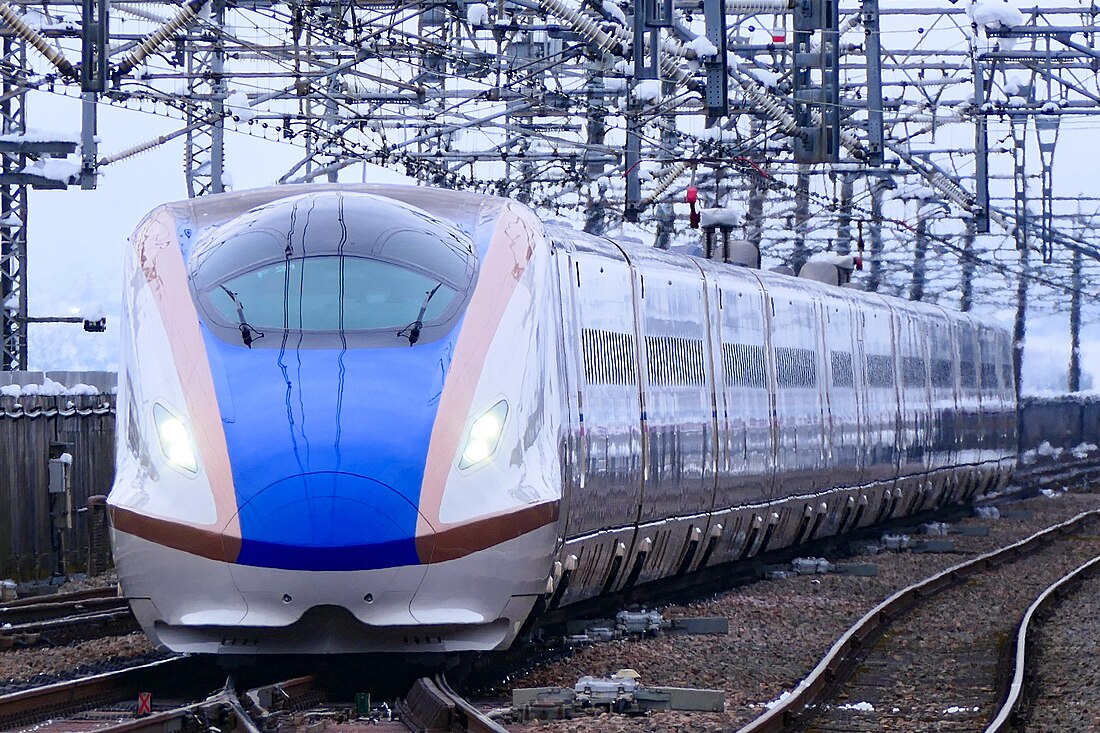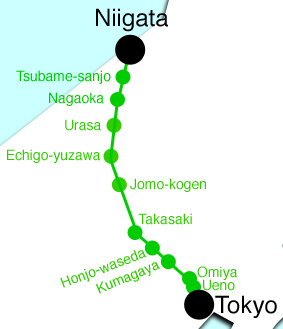Top Qs
Timeline
Chat
Perspective
Jōetsu Shinkansen
High-speed railway line in Japan From Wikipedia, the free encyclopedia
Remove ads
The Jōetsu Shinkansen (上越新幹線) is a high-speed shinkansen railway line connecting Tokyo and Niigata, Japan, via the Tōhoku Shinkansen, operated by the East Japan Railway Company (JR East). Despite its name, the line does not pass through the city of Jōetsu or the historical Jōetsu region, which instead are served by the Hokuriku Shinkansen. The name instead originates from the parallel Jōetsu Line, which in turn is named after the two provinces that it connects: Jōshū (an alternate name for Kōzuke Province which comprises today's Gunma Prefecture), and Echigo Province (modern day Niigata Prefecture).
You can help expand this article with text translated from the corresponding article in Japanese. (February 2023) Click [show] for important translation instructions.
|
Remove ads
Train services
- Toki, Tokyo – Niigata (limited-stop/ mostly all-stations since 30 December 2002) (Although it was first introduced as an all-stations service from 1982 to 1997)
- Tanigawa, Tokyo – Echigo-Yuzawa/ Gala-Yuzawa (Seasonal) (all-stations / mostly all-stations since 1 October 1997)
Discontinued services
- Asahi, Tokyo – Niigata (discontinued 30 November 2002)
- Max Asahi, Tokyo Niigata (discontinued 30 November 2002)
- Max Toki, Tokyo Niigata (discontinued 17 October 2021)
- Max Tanigawa, Tokyo – Echigo-Yuzawa/ Gala-Yuzawa (Seasonal) (discontinued 1 October 2021)
Remove ads
Stations
Summarize
Perspective
Legend:
- Although the official terminus of the Ryōmō Line is at Shin-Maebashi and that of the Agatsuma Line is at Shibukawa, trains on both lines run through to Takasaki.
The Gala-Yuzawa Line is a 1.8 km (1.1 mi) branch from Echigo-Yuzawa to Gala-Yuzawa Station. It operates in the winter months only, serving the adjoining ski resort.
As of 18 March 2023, the maximum line speed is 130.0 km/h (80 mph) between Tokyo and Omiya, and 275 km/h (171 mph) between Omiya and Niigata. The fastest Shinkansen from Tokyo to Niigata is 1 hour and 29 minutes, and 1 hour and 31 minutes from Niigata to Tokyo. Like all Shinkansen lines, the Jōetsu Shinkansen is standard gauge.
Remove ads
Rolling stock
As of 18 March 2023[update] the following train types operate on Jōetsu Shinkansen services.
Between fiscal 2018 and 2020, eleven 12-car E7 series train sets were introduced on Jōetsu Shinkansen services, replacing the E4 series trains,[1] raising the speed from 240 km/h (150 mph) to 275 km/h (171 mph).[2] Additional sets were gradually introduced through 2023 for the replacement of E2 series trains.
- An E7 series trainset
Non-revenue-earning types
Former rolling stock
- 200 series: Asahi / Toki / Tanigawa (1982 until March 2013)
- E1 series: Max Asahi / Max Toki / Max Tanigawa (until September 2012)
- E2 series: Toki / Tanigawa (January 2013 until March 2023)[3]
- E3 Series: Genbi Shinkansen excursion set (29 April 2016 until 19 December 2020)[4]
- E4 series: Max Asahi / Max Toki / Max Tanigawa (until October 2021)
- 200 series on a Tanigawa service in January 2011
- E1 series on a Max Asahi service in June 2002
- E2 series Shinkansen
- Set R19 E3-700 series Genbi Shinkansen in September 2016
- An E4 series trainset on a Max Tanigawa service in February 2021
History
Summarize
Perspective
The program to build the new line was initiated in 1971 by Niigata-born prime minister Tanaka Kakuei; one popular anecdote is that Tanaka determined the line's routing by drawing it on a map with a red pencil.[5] Built at a cost of $6.3 billion,[6] it was built "to establish closer ties with Tokyo and promote regional development".[7]
Trial runs over the line began in November 1980, and regular service began on 15 November 1982.[8] The line was initially planned to terminate at Shinjuku Station, but economic considerations pushed Japanese National Railways (JNR) to merge the line with the existing Tōhoku Shinkansen line at Ōmiya.
In September 1991, a 400 Series Shinkansen train set a Japanese rail speed record of 345 km/h (214 mph) on the Jōetsu Shinkansen line, and in December 1993, the STAR21 experimental train recorded 425 km/h (264 mph). The maximum speed for regular services on the line at the time was 245 km/h (150 mph) except for the section between Jomo-Kogen and Urasa which is 275 km/h (171 mph) for E2 series trains travelling towards Niigata. The urban section between Tokyo and Ueno is 110 km/h (70 mph), between Ōmiya and Ueno is 130 km/h (80 mph).[9][10]
The Basic Plan specifies that the Jōetsu Shinkansen should actually start from Shinjuku, which would necessitate building 30 km (19 mi) of additional Shinkansen track from Ōmiya. While some land acquisitions along the existing Saikyō Line were made, no construction ever started.[citation needed]
The entire line was upgraded to 275 km/h (171 mph), with construction starting in May 2019, and finished in 2023.[11] Upgrades included improvements to the soundproofing system.[12] This marks the first time that an E7 series train has operated commercially at more than 260 km/h (160 mph), which is the maximum speed of the only other line served by this train, the Hokuriku Shinkansen. As a result of the upgrades, all trainsets on the Jōetsu Shinkansen operate exclusively with E7 series trainsets and the travel time on the line is projected to be reduced by 7 minutes compared to the former E2 and E4 series trainsets.[12] The end of E2 series trainsets on Jōetsu Shinkansen services took take place on 17 March 2023 with the streamlining of all services to use the E7 series taking place the following day.[13]
Future plans
The Niigata prefectural government has proposed building a new multi-modal terminal to directly connect the Shinkansen to the port of Niigata, potentially allowing direct transfers to ferries and cruise ships, and to potentially allow direct access between the Shinkansen and Niigata Airport. However this plan is foreseen to be completed only by the mid-2040s.[14]
Remove ads
Special event train services
On 17 November 2012, a special Joetsu Shinkansen 30th Anniversary (上越新幹線開業30周年号, Jōetsu Shinkansen Kaigyō 30-shūnen-gō) service ran as Toki 395 from Omiya to Niigata using 10-car 200 series set K47.[15]
Also on 17 November 2012, a special Joetsu Shinkansen 30th Anniversary (上越新幹線開業30周年号, Jōetsu Shinkansen Kaigyō 30-shūnen-gō) service ran from Niigata to Tokyo using E5 series set U8, with a special ceremony at Niigata Station before departure.[16][17] This was the first revenue-earning service operated on the Joetsu Shinkansen by an E5 series trainset.[17]
Remove ads
Film
- Susanne Steffen: From Tokio to japanish sea. NDR, 2022, 45 Min
See also
References
External links
Wikiwand - on
Seamless Wikipedia browsing. On steroids.
Remove ads








